
There are a number of reasons why owning a dog benefits your health, with the first being that it may encourage you to be more active. Can my dog improve my wellbeing?
Many studies have proven that owning a dog has many health benefits for families with kids, singles, seniors and having dogs at work.
No matter if you live alone or not, you too can discover what makes owning a dog so good for you.
Dog Benefits for Families With Kids
How beneficial is it for babies and kids to be raised around dogs?
One of the many benefits of dog ownership is that it improves the health of babies and children who have a furry family member.
Health Benefits
Babies can experience the benefits of a dog from the moment they are in their mother’s womb. A new study by the University of Alberta showed that babies from families with pets – 70% of which were dogs – showed some interesting results.
The exposure to pets while in the womb or up to 3 months of age increased the levels of two strains of gut bacteria:
- Ruminococcus: Linked to a reduction in childhood allergies.
- Oscillospira: Linked to childhood obesity.
Anita Kozyrskyj – Ph.D., study co-author, University of Alberta pediatric epidemiologist, and a leading researcher on gut microbes – and her departments’ research stem from the theory that exposure early in life to dirt and bacteria from, for example, a dog’s paws and fur, can create early immunity.
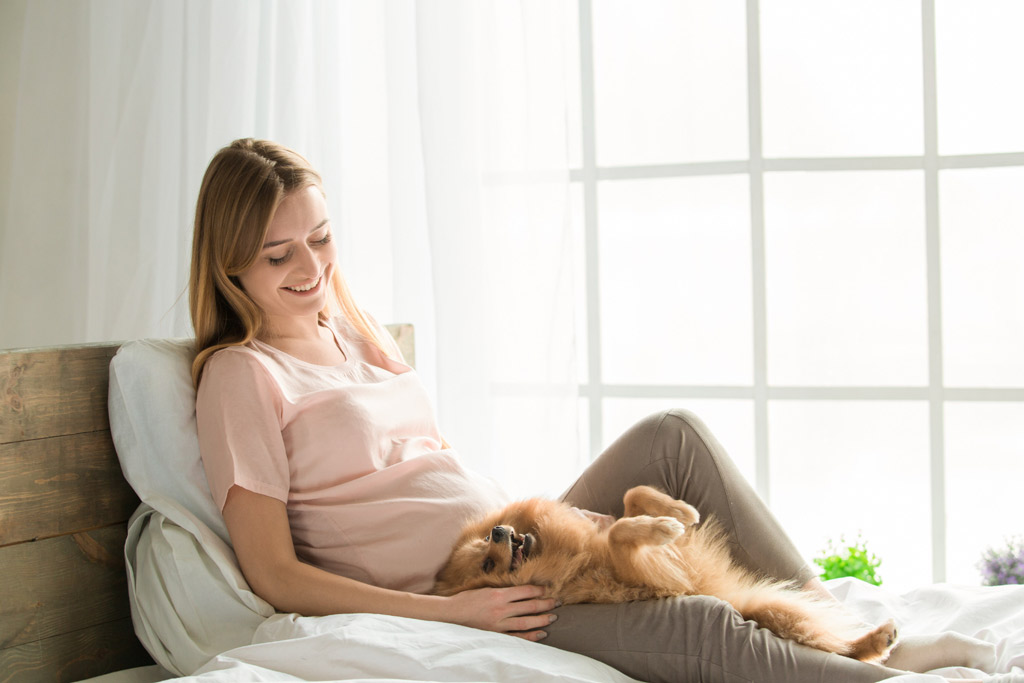
The levels of these two bacteria were twice as high in babies with exposure to a pet at home. The route of exposure is indirect, from dog to mother to baby during pregnancy as well as the first 3 months of pregnancy. This means that even if the dog was no longer around at the time of the baby’s birth, his or her microbiome would still benefit from the exchange of health-giving bacteria.
In addition, the exchange occurred even in higher-risk birth situations including:
- A C-section delivery.
- When the mother was taking antibiotics at the time of birth.
- And when the mother didn’t breastfeed.
Yet another protective benefit is that the presence of pets in the home reduced the incidence of transmission of vaginal GPS (group B strep) during birth. This causes pneumonia in newborn infants (and is the reason mothers are sometimes given antibiotics during delivery).
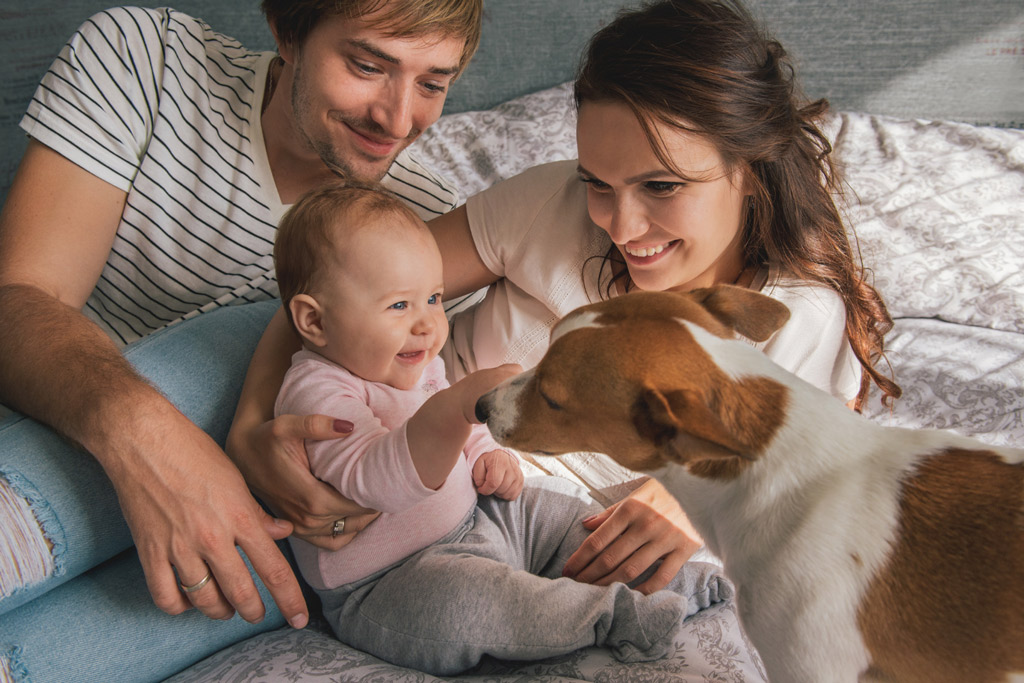
Stress Response Benefits
Dogs provide valuable social support for kids in stressful situations and can help bring down their stress levels.
“Many people think pet dogs are great for kids but scientists aren’t sure if that’s true or how it happens. How we learn to deal with stress as children have lifelong consequences for how we cope with stress as adults. Children who had their pet dog with them reported feeling less stressed compared to having a parent for social support or having no social support.”
Darlene Kertes, an assistant professor at the University of Florida’s psychology department.
But the way kids interact with their dogs also plays a part in this.
“Children who actively solicited their dogs to come to be stroked had lower cortisol levels compared to children who engaged their dogs less. When dogs hovered around or approached children on their own, however, children’s cortisol tended to be higher.”
Darlene Kertes, an assistant professor at the University of Florida’s psychology department.

Emotional Benefits
According to another study, children attached to their pets tend to function better emotionally; and their self-esteem is enhanced by owning a dog.
“Whereas social feedback given by humans can feel critical and threatening, the nonjudgmental support offered by a beloved pet makes your child feel unconditionally accepted.”
Dr Karen Becker, an integrative veterinarian.
Helping to care for the family pet teaches children how to nurture a dependent creature. Apart from feeling like a responsible person, your kids learn about compassion and empathy. At the same time, they understand the dog’s needs and feelings.
Family dogs can also aid in teaching your children about important life events like birth and death. Helping your child to understand and express feelings of sadness and loss when a dog dies or is euthanized can influence how your kids cope with the experience of death throughout their life.
It’s always great to prepare your dog for your baby’s arrival, just to smooth things a bit and make the experience far more enjoyable. If you want to know more, check out Introducing your dog to your baby step by step.
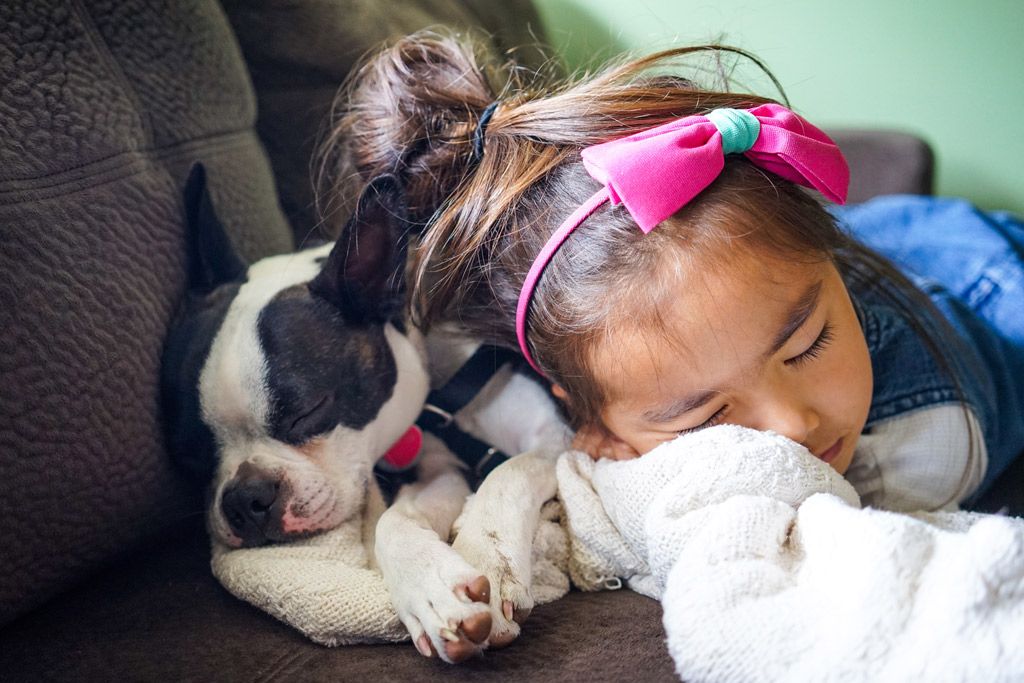
Dog Benefits for Singles
Social Benefits
Singles, in particular, may benefit further because dogs act as a social stimulus and can be a catalyst to forming new friendships. Dog owners are significantly more likely to get to know people in their neighbourhood than non-pet owners, for instance.
Health Benefits
Separate studies have shown that dog owners engage in more walking and physical activity than non-dog owners. Although it’s also true that active people are more likely to adopt dogs in the first place.
Still, if your furry friend gives you his puppy-dog eyes, wouldn’t you get off the couch and go for a walk?
Dog ownership is also a great way to introduce movement to your life when going for walks or just adding more variation to your fitness routine!

Dog Benefits at Work
Dogs at work have many benefits:
- U.S. workers ranked having pets at work as the second most valuable work benefit.
- 8 in 10 of those working in pet-friendly environments said that having their pet at work increased feelings of happiness and relaxation while making them more sociable.
- 63% of employees said they’d be more enthusiastic about interviewing for a new job if it had pet-friendly policies.
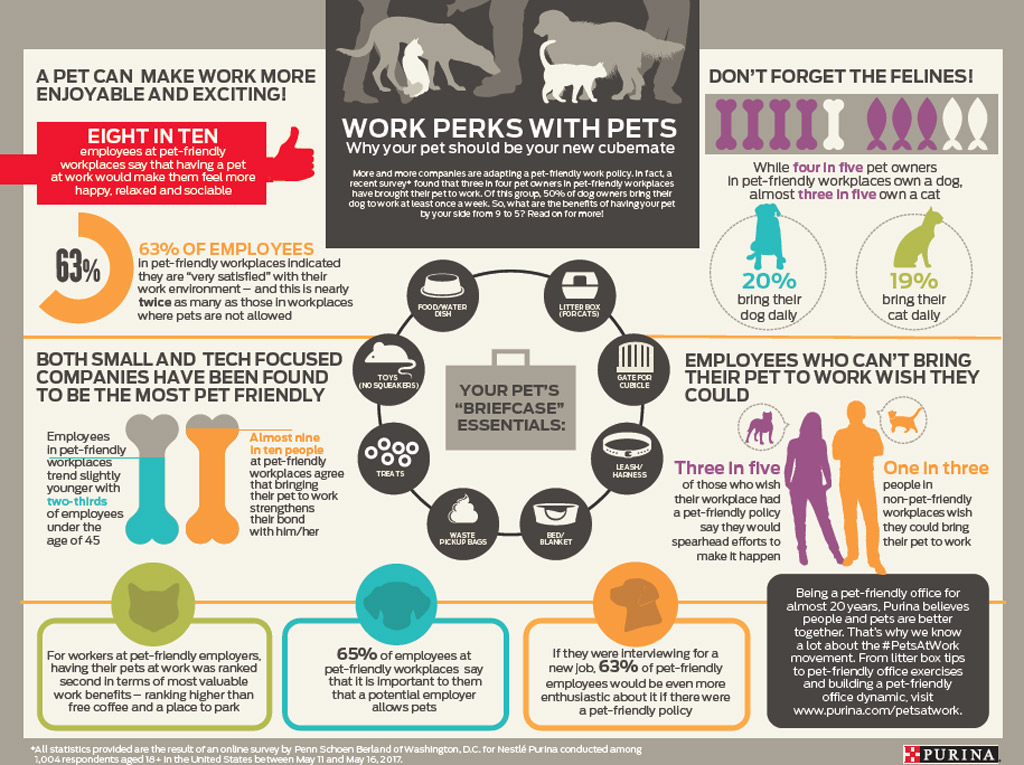
Nestle Purina PetCare created its first Pets at Work Report – examining pet owners and their attitudes around having pets in the workplace, and the benefits it brings to employers and employees.
The survey found that pet-friendly work environments are viewed as both exciting and innovative.
More than half of dog owners in pet-friendly workplaces bring their dog to work at least once a week in addition to lunch meetings, work parties and meetings with their boss.
The survey also showed that employees at pet-friendly organizations ranked having pets at work second in terms of most valuable work benefits – ranking higher than free coffee and parking.

What do Dogs Offer in the Workplace?
#1 – Satisfactory Work Environment
Increased satisfaction with the work environment is quite significant for both employers and employees. About 63% of employees working in pet-friendly workplaces said they were “very satisfied” with the work environment, which is nearly double the number as those in workplaces without pets.
#2 – Happiness and Relaxation
8 in 10 of those working in pet-friendly environments said that having their pet at work increased feelings of happiness and relaxation while making them more sociable.
#3 – Calm and Movement
Dr Kurt Venator, Ph.D., who was involved in Purina’s Pets at Work Report, noted that pets may bring a calming presence during challenging tasks or encourage employees to take a walk during their lunch break, which is good for the brain especially after intense periods of focus.
#4 – Stress Reduction and Job Satisfaction
Stress is a major contributor to employee absenteeism, morale and burnout and results in significant loss of productivity and resources.
Over the course of a workday, one study found that employees’ stress tended to increase over the course of the day. However, those who had their dogs present actually had their stress levels decline, while the non-pet employees around them got increasingly stressed out.
“Dogs in the workplace can make a positive difference in the workplace, leading not only to significantly lower perceived stress but also higher job satisfaction.“
Randolph T. Barker, Ph.D., professor of management in the VCU School of Business.

“Given that many individuals in today’s workforce struggle with long work hours, increasing job demands, and high stress, the notion of dog-friendly work settings to help mitigate these stressors has great appeal to both employees and employers. Indeed, the benefits of dog-friendly workplaces may manifest as lower rates of absenteeism and higher worker morale and productivity.”
Randolph T. Barker, Ph.D., professor of management in the VCU School of Business.
What Dog Owners Said
- For employers, offering workers the chance to bring pets to work is a huge incentive.
- 63% of employees said they’d be more enthusiastic about interviewing for a new job if it had pet-friendly policies.
- 65% said it’s important for potential employers to allow pets, with many employees taking advantage of their company’s pet-friendly policies.
- The Pets at Work Report found that 3 in 4 workers bring their pet to work if it’s allowed, with 50% bringing their dog to work at least once a week.
- 20% bring their dog on a daily basis while 19% bring their cat.
- Many reported that bringing their pet to work strengthened their bond with him.
- It’s also quite revealing that 1 in 3 employees working at non-pet-friendly establishments say they wish they could bring their pet to work.

Pet-Friendly Workplaces
If bringing your pet to work is important to you, you may want to research companies with pet-friendly policies. Genetech, Kimpton hotel and restaurant group, and Amazon are some well-known companies that offer such benefits.
If it’s important to you and you’re looking for a new job, the time to ask about such benefits is during the interview phase, as some companies are even using pet perks as recruitment tools.
Beyond allowing pets at work, some companies offer additional benefits, such as:
- Discounts to doggie daycares.
- Reduced pet insurance rates.
- Pawternity leave.
- Paid pet bereavement days.
- And even dog-lovers clubs that organize meetups for members!
Depending on your level of desire to bring your pet to work, choosing to work for a company that offers these and other pet-friendly policies could enhance your well-being at work considerably.

Cons to Pets at Work
Despite the many benefits, only 8% of respondents to the 2015 Society for Human Resource Management’s Employee Benefits survey said their workplaces permitted pets in the US (an increase from 5% in 2013).
There are many reasons for workplaces not being pet-friendly:
- Environment and space: Some workspaces are not appropriate for pets. Even among office environments, there are considerations that must be reviewed.
- Allergies: 15 to 30% of people with allergies are allergic to dogs and cats. Using air filters to reduce dander in the air as well as designating dog-free areas could be a solution.
- Diseases: Zoonotic diseases, or those that can be transmitted between pets and people, are another potential problem. Although this is reduced if the animals are healthy and waste is picked up promptly.
- Pet bites: Many employers also worry about the potential for dog bites. Also, the legal responsibilities surrounding them if they occur in the workplace, which varies widely by state and country.
- Fear of dogs: Up to 11% of Americans also say they are afraid of dogs and should have the opportunity to work in a dog-free environment if that’s the case.
- Pet’s wellbeing: Concerns for the well-being of the pet must also be addressed. These include ensuring adequate time for the dog or cat to play, exercise and be taken outdoors to relieve himself.
- Multiple pets at work: If multiple pets are brought to the workplace, attention must also be paid to ensuring the animals get along and do not fight.

The International Journal of Environmental Research and Public Health researchers offered the following advice to management personnel considering pets in the workplace:
“Allowing pets in the workplace undoubtedly affects employee relations. To avoid potential conflicts, it is important to devise a strategy for incorporating employee input into decisions involving dogs in the workplace. Some employees may be hesitant to express their reservations or concerns because of fear of judgment by other employees. So an avenue for anonymous submission of feedback may be appropriate.”
Plus…
“One approach for handling concerns that have been adopted at some pet-friendly workplaces where there are multiple pet dogs present is the creation of a ‘Dog Committee,’ which is a special committee of employees to evaluate issues and concerns related to the dogs as they arise.”
Dog Benefits for Seniors
Health Benefits
More importantly, for older adults, dog walking is associated with many benefits like:
- Lower body mass index.
- Fewer doctor visits.
- Fewer limitations to daily living.
- More frequent moderate and vigorous exercise.
As loneliness and social isolation are known risk factors for heart disease, your dog’s ability to act as a conduit for new friendships is a big benefit. Plus, they compensate for the absence of human companionship at home.
Whatever your age, the mutual gazes shared between you and your dog lead to the release of oxytocin. This is the “love hormone” that’s also protective of your heart and makes you feel great!

Dogs Combat Loneliness
Certainly, if all those reasons didn’t convince you… a new initiative in the U.K. pairs lonely seniors with local dogs. The main goal is to keep the elderly from being lonely and gives them something to look forward to.
This is highly beneficial for both parts since it helps dogs fulfil what they love doing: providing friendship and a social connection.
How Does it Work?
Dog Dates, launched in the U.K. and run by Mars Petcare, matches elderly individuals with dogs in the same locality who need social time themselves. The pairs can spend as much time as they’d like each other (source).
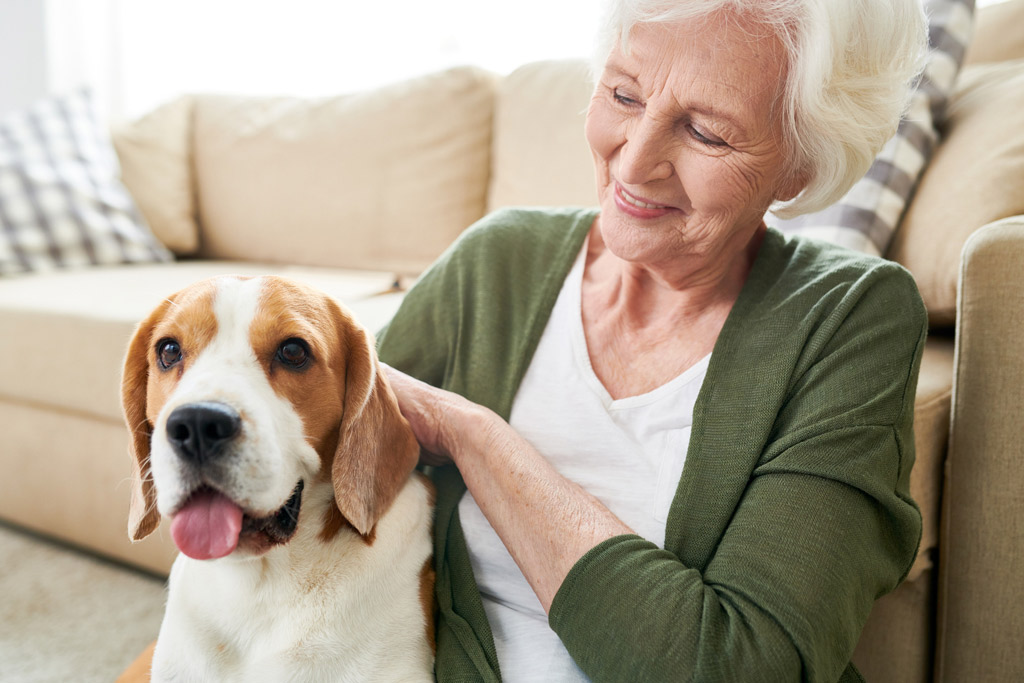
What do the Studies Say?
One of the saddest aspects of life is loneliness, and regardless of your demographic, being elderly may make you feel it more keenly than any other group. A recent study conducted by Age UK reports that 1.9 million elderly people feel ignored and invisible.
According to Sandra McCune, a scientific expert in human-animal-interaction, this “crisis of loneliness and social isolation,” is not only affecting the age group you might immediately expect.
“You expect to see loneliness in older adults because our networks seem to shrink a bit as we get older – although this is not always the case. But what we are finding from several of the surveys, and from different NGOs, is that the results for loneliness are higher in the millennial age group, with half of 18 to 24-year-olds feeling socially isolated.
The suspicion is that it might have something to do with how millennials interact virtually rather than face-to-face.”
Sandra McCune, a scientific expert in human-animal-interaction.
So, Why are Dogs So Good for Loneliness?
Evidently, they are amazing social connectors. Over 80% 0f people who took part in the Mars Petcare research said that just one month after getting a dog, they felt a lot less lonely.
At the end of the day, it’s a connection with others that makes the difference for humans, and connection with a loving dog may fit the bill especially when no other alternatives seem available, offering benefits to both the person and the doggy.
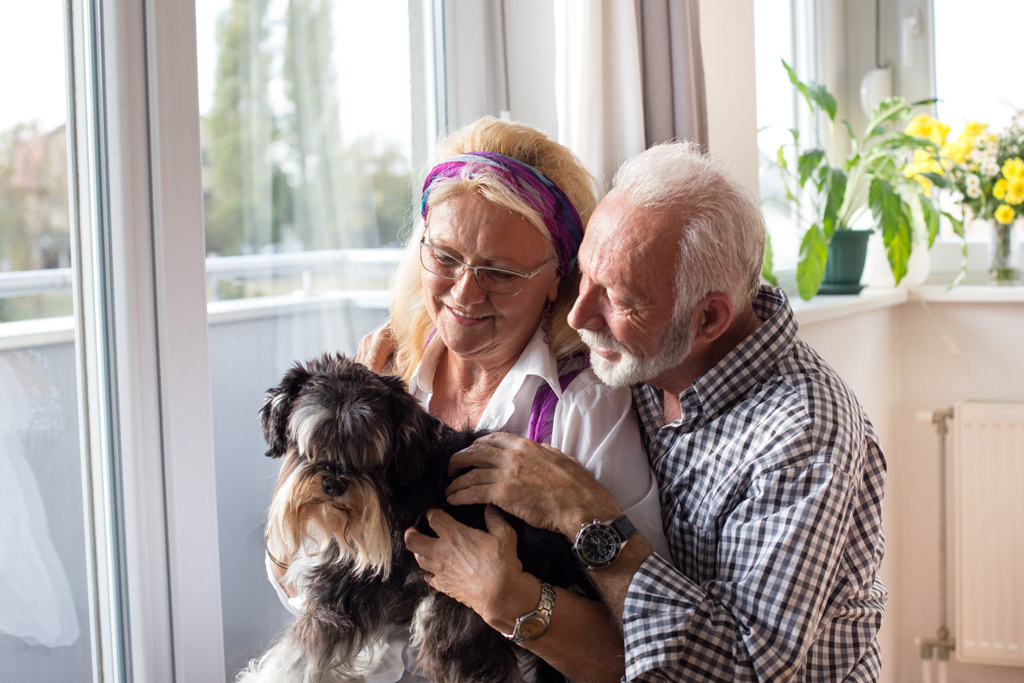
P.S. If you want to know more about dog care, check out our The 5 pillars to a happy and healthy dog blog post.
